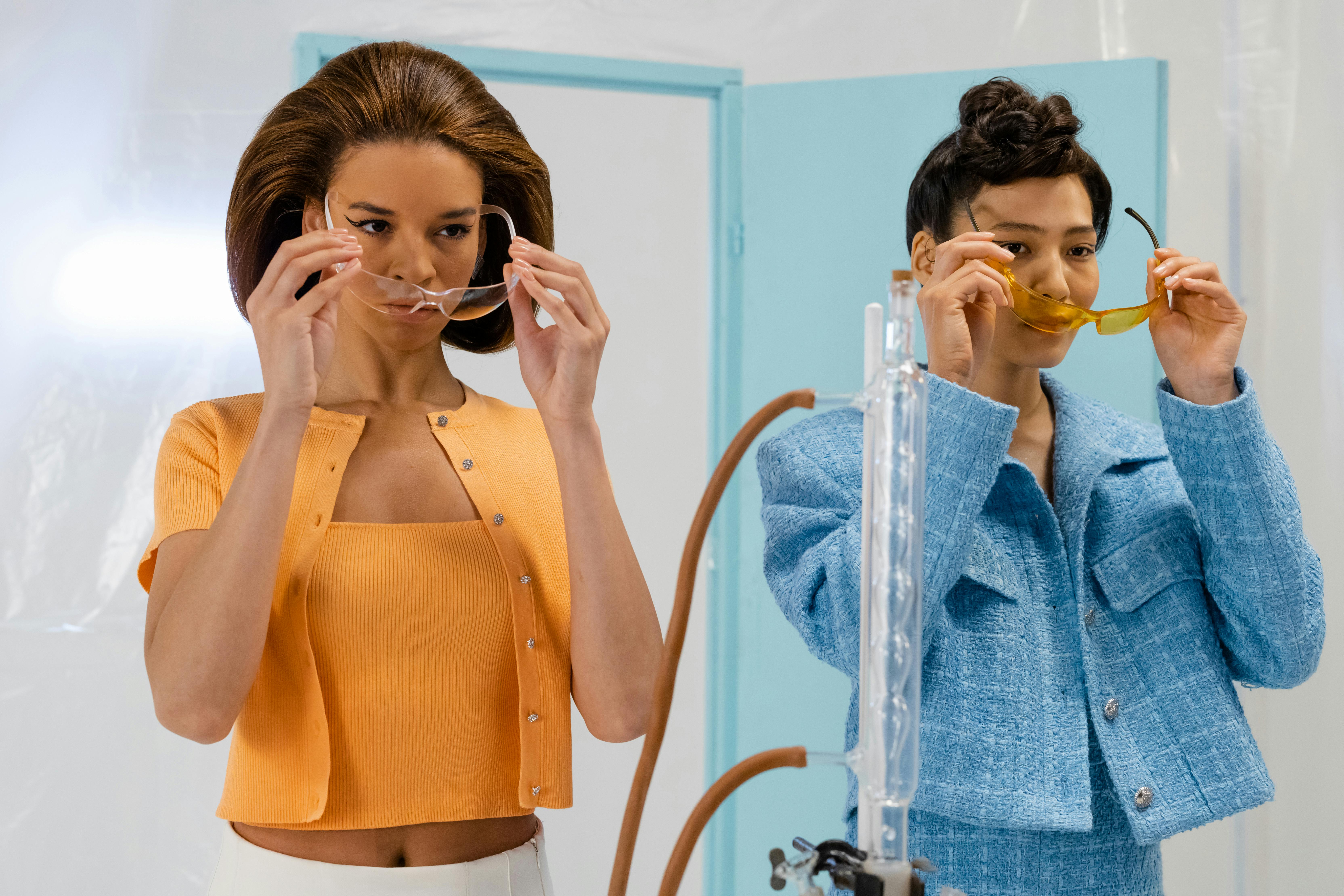What Do Scientists Wear

Scientists often wear specific clothing to protect themselves from hazardous materials that they may come in contact with in their work. Depending on the field of study, a scientist is likely to wear protective clothing such as lab coats, safety glasses, gloves, and face shields. In some cases, more specialized attire may be required. For example, a biologist who works with live animals may need to wear boots and coveralls to protect against disease and infection. In addition to providing protection from potential hazards, scientists also need to wear clothing that is comfortable for long hours of laboratory work.Scientists typically wear comfortable clothing such as polo shirts, slacks, khaki pants, and closed-toe shoes. They may also need to wear safety gear such as lab coats and goggles when performing experiments. The type of clothing worn by scientists may vary depending on the type of research they are conducting and the environment they are working in.
How Should a Scientist Dress?
When it comes to dressing as a scientist, the key is to ensure that you look professional and presentable. This means wearing clothing that is neat and appropriate for the work environment. For men, this could mean wearing slacks or khakis with a dress shirt, tie, and dress shoes. Women could opt for a skirt suit or dress pants with a dress shirt, blouse, and dress shoes. It’s also important to make sure your clothing is comfortable and not too restrictive as you will be engaging in physical activity such as conducting experiments or fieldwork.
In addition to looking professional, it’s important to keep safety in mind when selecting your wardrobe. Certain laboratories may require certain protective equipment such as safety glasses or lab coats that protect against hazardous materials. Depending on the type of research you are conducting, you may need protective clothing such as rubber boots or waterproof jackets for fieldwork.
Overall, it’s important to make sure your clothing reflects your level of professionalism while also providing comfort and protection for any activities you may be engaging in as a scientist.
Protective Clothing for Scientists
Protective clothing is essential for scientists who work with hazardous materials in the lab. Whether working with chemicals, radiation, or other hazardous substances, researchers need to wear appropriate protective clothing in order to protect themselves from potential harm. Protective clothing items can include lab coats, safety glasses, face shields, respirators, gloves, and aprons. Lab coats provide a layer of protection against spills and splashes of hazardous substances. Safety glasses protect the eyes from chemical splashes and flying particles. Face shields offer additional protection from splashes and particles that may otherwise reach the face and eyes. Respirators help filter out dangerous airborne particles which may be present in a lab environment. Gloves provide a barrier between the hands and potentially harmful substances. Lastly, aprons provide additional protection for areas of the body that may be exposed to hazardous materials or chemicals. All scientists should select appropriate protective clothing items based on their individual needs and the types of hazards they are likely to encounter in their work environment.
It is important for scientists to remember that protective clothing should fit properly in order to provide optimal coverage and protection. In addition, protective clothing should be inspected frequently for signs of wear or damage that could render them less effective at protecting against hazards in the workplace. Finally, it is also important for scientists to remember that protective clothing should always be worn when working with hazardous materials – even if it seems like a minor risk – as it can help prevent serious injury or illness due to exposure to potentially harmful substances.
Lab Safety Clothing for Scientists
Scientists working in a laboratory must wear the proper safety clothing to protect themselves and their colleagues. Lab safety clothing includes items such as lab coats, safety glasses, gloves, face masks, and shoe covers. Lab coats are essential for protecting the wearer from hazardous chemicals and spills. They should also be long enough to cover any exposed skin, such as the wrists or neck. Safety glasses provide essential protection from chemical splashes and other hazards in the lab. They should fit snugly against the face and be scratch-resistant. Gloves are another important item of lab safety clothing that helps protect against chemical exposures or burns. Face masks are also essential when working with hazardous chemicals or materials in a laboratory setting. Lastly, shoe covers help keep the laboratory floor clean and free from contaminants that may be carried in from outside sources.
Lab safety clothing is an important part of any laboratory environment to ensure that all scientists remain safe while working with hazardous materials or chemicals. It is important for scientists to wear the proper protective clothing when working in a laboratory to protect themselves and those around them from potential harm caused by exposure to hazardous materials or chemicals. All lab personnel should be aware of what items should be worn in order to stay safe while conducting experiments in a laboratory environment.
Types of Scientific Apparel
Scientific apparel is a must-have for any laboratory or research environment. It provides protection from hazardous materials and chemicals, and helps to ensure researchers remain safe while conducting experiments. There are several types of scientific apparel available, each designed to meet the specific needs of the research environment.
Lab coats are a common type of scientific apparel, and they provide basic protection from spills and splashes. They can also be used to store lab equipment, such as pipettes, beakers, and other tools. Lab coats come in a variety of colors, sizes, and materials. Some lab coats even feature pockets for extra storage space.
Protective gloves are another type of scientific apparel that is essential for any laboratory or research environment. These gloves protect the hands from contact with hazardous materials and chemicals. They come in a variety of materials, such as latex and nitrile, to suit different applications.
Safety glasses are also an important part of scientific apparel. These glasses protect the eyes from flying objects or chemical splashes that could cause serious injury. Safety glasses come in various shapes, sizes, and colors to suit different needs.
Finally, respirators are a critical piece of safety equipment that should not be overlooked when it comes to scientific apparel. Respirators provide protection from airborne particles that could damage the lungs if inhaled in large amounts over time. They come in a variety of styles and sizes to fit every user’s needs.

Clothing for Working in a Laboratory
Working in a laboratory can be a dangerous job. It is important to wear the right clothing to protect yourself from the potential hazards in the lab. Proper laboratory attire includes long pants, closed-toe shoes, and a lab coat or other protective clothing. Long pants and closed-toe shoes help protect your legs and feet from spills or splashes of hazardous materials. A lab coat can help keep you safe from chemical splashes and other hazards. It should fit properly, be made of a material that is resistant to chemical spills, and have pockets for storing tools and supplies. It is also important to keep your hair tied back so that it does not come in contact with any hazardous materials. In addition, safety glasses with side shields should always be worn when working in the lab.
When working with biohazardous materials, additional protective clothing is advised such as gloves, face masks, and shoe covers. Gloves should fit properly and be replaced when they become worn or damaged. Face masks should fit snugly over your nose and mouth to provide protection against airborne particles or aerosols. Shoe covers are used to prevent contamination of the lab environment by keeping dirt and debris off the floor. Finally, it is important to avoid wearing loose fitting clothing that could become caught on equipment or other objects in the lab environment.
Proper clothing for working in a laboratory can help you stay safe while conducting experiments or performing other tasks related to research or studies in the lab environment. Wearing appropriate protective clothing will ensure that you are protected from potential hazards such as chemical spills or biohazards that may be present in the lab environment.
Caring for Scientific Apparel
When caring for scientific apparel, it is important to keep in mind that the items are made of delicate fabrics that require special attention. The best way to care for scientific apparel is to launder them separately from other items and use gentle detergents. It is also important to avoid using fabric softeners, as this can damage the fabric and reduce the effectiveness of the garment. When drying scientific apparel, be sure to use low heat settings and remove items promptly when finished. If an item must be ironed, use a low heat setting and never directly iron over any logos or patches. Lastly, when storing scientific apparel it is important to make sure the items are hung up on hangers or folded neatly and placed in a cool, dry place. Following these simple tips will help ensure that your scientific apparel stays looking great for years to come.
In addition to following basic laundering instructions, it is also important to inspect all scientific apparel before wearing. Check for any signs of wear or damage that could affect the functionality of the garment. If any rips or tears are found, they should be repaired immediately before wearing the item. This will help ensure that your garments remain safe and secure while you are working or conducting experiments in a laboratory setting.
Choosing the Right Clothes for Scientific Research
When conducting scientific research, it is important to choose the right clothes to ensure safety and comfort. It is essential to wear clothing that will protect you from any potential hazards, as well as keep you comfortable during the research activities. The following are some tips for choosing the right clothes for scientific research:
First, it is important to consider the environment in which you will be conducting research. Depending on the type of research, you may need to wear protective gear such as goggles or face masks. Additionally, you should also consider wearing long-sleeved shirts or pants to protect against any sharp objects or chemicals that may be present. Depending on the environment, it may also be necessary to wear waterproof clothing.
Second, it is important to choose clothes that are comfortable and allow for freedom of movement. Research activities can often involve long hours of standing or walking and thus it is important to choose clothing that will not be constricting or cause discomfort. Shoes should also be chosen carefully and should provide adequate support and protection from any potential hazards.
Finally, it is important to consider any safety regulations that may be in place in your particular workplace when choosing your research attire. Certain workplaces may require specific types of clothing in order to ensure safety standards are met. Additionally, if there are any flammable materials present or if there is potential for exposure to hazardous chemicals, flame-resistant clothing may be required.
By considering these factors when selecting your research attire, you can ensure a safe and comfortable working environment while conducting scientific research.

Conclusion
The type of clothing scientists wear varies depending on the type of research they are conducting and the environment they are in. In the lab, scientists usually opt for professional attire such as a lab coat or button-down shirt and slacks. For field research, clothing must be more practical, such as waterproof boots and breathable layers. Finally, when attending conferences or giving presentations, scientists typically dress in more formal clothing than they would wear in the lab or while conducting field research.
Overall, when it comes to what scientists wear, there is no one-size-fits-all answer. However, there are certain factors that should be taken into consideration when selecting appropriate attire for a given situation. By following these guidelines, scientists can ensure that their clothing choices adhere to safety requirements while still allowing them to look professional and present themselves as knowledgeable experts in their field.
With this information in mind, it is possible for anyone interested in science to make informed decisions about what clothes are best suited for any given scientific situation. From lab coats to waterproof boots, by understanding the correct attire for each situation, scientists will be able to look and feel their best while doing their important work.
